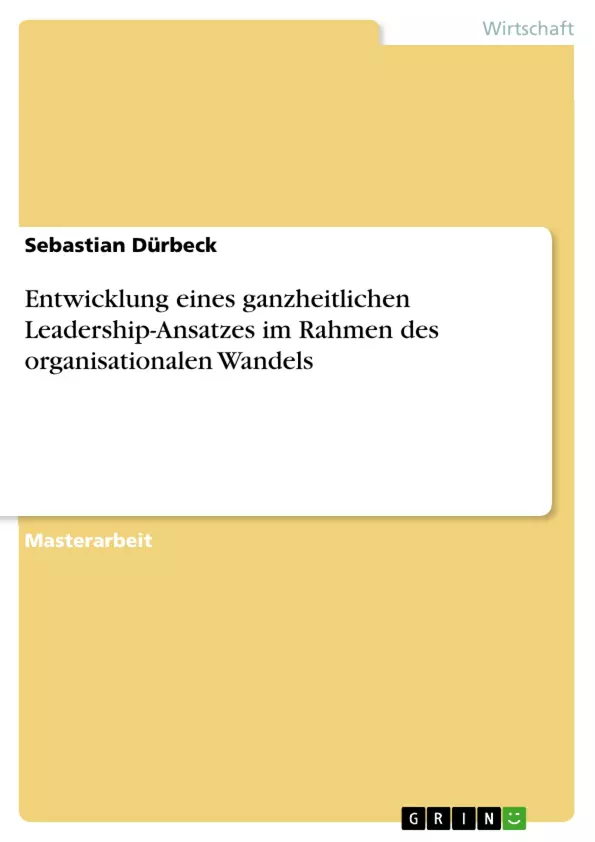Diese Arbeit analysiert, welches Führungsverhalten in Organisationen nötig ist, um Mitarbeitern eine Teilhabe am Wandel zu ermöglichen und sie zu befähigen, auf die grundlegenden Anforderungen von Veränderungsprozessen adäquat reagieren zu können. Es werden dabei erfolgskritische Grundmuster aufgezeigt, wie Führungskräfte ihre Leadership-Aufgaben mit den Aufgaben eines Change-Managers kombinieren können und damit zu einem "Change Leader" werden.
Inhaltsverzeichnis
- 1. Wandel als Normalzustand
- 1.1. Bedeutung von Wandel in der Gesellschaft und in Organisationen
- 1.2. Grundlegende Folgen von Wandel für Unternehmen
- 1.3. Zielsetzung und Aufbau der Arbeit
- 2. Grundlegendes Verständnis von Organisationen und Wandel
- 2.1. Betrachtungsweise von Organisationen
- 2.1.1. Organisationsmerkmale
- 2.1.2. Organisationsstruktur
- 2.1.3. Organisationssicht
- 2.1.4. Entwicklungsphasen einer Organisation
- 2.2. Komplexität als Regelfall
- 2.2.1. Begriffsabgrenzung
- 2.2.2. Umgang mit Komplexität
- 2.3. Systemtheoretischer Ansatz
- 2.3.1. Grundlagen der Systemtheorie und Kybernetik
- 2.3.2. Organisationen als soziale Systeme
- 2.4. Aspekte des Wandels
- 2.4.1. Begriffsabgrenzungen
- 2.4.1.1. Veränderung und Wandel
- 2.4.1.2. Unternehmenstransformation
- 2.4.1.3. Organisationsentwicklung
- 2.4.1.4. Change Management
- 2.4.1.5. Transition
- 2.4.2. Veränderungsbeteiligte und -ebenen
- 2.4.2.1. Individuum und Team
- 2.4.2.2. Organisation und Struktur
- 2.4.2.3. Unternehmensumwelt
- 3. Einflussfaktoren im Rahmen von Veränderungsprozessen
- 3.1. Psychologische Faktoren
- 3.1.1. Bedeutung von Emotionen
- 3.1.1.1. Begriffsabgrenzung
- 3.1.1.2. Entstehung von Angst und Widerstand
- 3.1.2. Einfluss von Motivation
- 3.1.2.1. Begriffsdefinition
- 3.1.2.2. Motivationstheorien
- 3.1.2.2.1. Inhaltstheorien
- 3.1.2.2.1.1. Bedürfnishierarchie
- 3.1.2.2.1.2. Zwei-Faktoren-Theorie
- 3.1.2.2.1.3. Job Characteristics Model
- 3.1.2.2.2. Prozesstheorien
- 3.1.2.2.2.1. Instrumentalitätsmodell
- 3.1.2.2.2.2. Rückkopplungsmodell
- 3.1.2.2.3. Aktionstheorien
- 3.1.2.2.3.1. Situation
- 3.1.2.2.3.2. Emotion
- 3.1.2.2.3.3. Intuition
- 3.1.2.2.3.4. Volition
- 3.2. Organisationale Einflussgrößen
- 3.2.1. Organisationskultur
- 3.2.2. Kommunikation
- 3.2.3. Lernebenen und -formen
- 3.2.4. Teamentwicklung
- 4. Konzepte des organisationalen und individuellen Wandels
- 4.1. Basisansätze
- 4.1.1. 3-Phasen-Modell des individuellen Lernens
- 4.1.2. 3W-Modell des Wandlungsprozesses
- 4.1.3. 5-Stufen-Modell des Wandelprozesses
- 4.1.4. 8-Stufen-Prozess des tiefgreifenden Wandels
- 4.2. Individuell-emotionale Konzepte
- 4.2.1. 7-Phasen-Modell von Veränderungsprozessen
- 4.2.2. 6-Phasen-Modell der emotionalen Achterbahn
- 4.2.3. 7-Stufen-Modell der emotionalen Steuerung
- 4.2.4. 11-Stufen des Heldenprinzips
- 4.2.5. COR-ESSENTIALS-Modell
- 4.2.6. Dragon Dreaming und Appreciative Inquiry
- 4.3. Hybrid-integrative Strukturen
- 4.3.1. Lernende Organisation
- 4.3.2. Duales Betriebssystem
- 4.3.3. Holacracy
- 4.3.4. Integrale Organisationsentwicklung
- 4.3.5. Agile Organisation
- 4.3.6. Zusammenführung hybrid-integrativer Modelle
- 5. Führungshandeln im Veränderungsprozess
- 5.1. Bedeutung von Management im organisationalen Wandel
- 5.2. Verständnis von Leadership in Veränderungsprozessen
- 5.3. Einteilung grundlegender Führungsmodelle
- 5.3.1. Transaktionale Führung
- 5.3.1.1. Grundformen
- 5.3.1.1.1. Führungskontinuum
- 5.3.1.1.2. Kontingenztheorie
- 5.3.1.2. Ohio-State-Forschung
- 5.3.1.2.1. Verhaltensgitter der Führung
- 5.3.1.2.2. Reifegradmodell der Führung
- 5.3.2. Transformationale Führung
- 5.3.2.1. Charismatische Führung
- 5.3.2.2. Visionäre Führung
- 5.3.2.3. Fordernde Führung
- 5.3.2.4. Fördernde Führung
- 6. Führungsanforderungen im Wandel
- 6.1. Ebenen des Wandels
- 6.1.1. Integrativ-psychologisches Modell
- 6.1.2. Theorie U
- 6.2. Veränderungs- und Innovationsfähigkeit
- 6.2.1. Veränderungskompetenz
- 6.2.2. Innovationskompetenz
- 6.3. Konfliktfähigkeit
- 6.3.1. Sichtweise auf Konflikte
- 6.3.2. Konfliktmanagement und -prävention
- 6.3.3. Mediationskompetenz
- 6.4. Fähigkeit zur Widerstandsbearbeitung
- 6.4.1. Bedeutung von Widerstand
- 6.4.2. Bearbeitung von Widerständen
- 6.4.3. Vertrauensaufbau
- 6.5. Change-Leadership
- 6.5.1. Führungsanforderungen
- 6.5.2. Führungsverhalten
- 6.5.3. Führungsmotivation
- Die Bedeutung von Wandel in der Gesellschaft und in Organisationen
- Die Folgen von Wandel für Unternehmen
- Die Rolle von Leadership im Veränderungsprozess
- Die Bedeutung von Motivation und Konfliktfähigkeit im Wandel
- Die Herausforderungen der Widerstandsarbeit im Change Management
Zielsetzung und Themenschwerpunkte
Die Arbeit befasst sich mit der Analyse des Führungsverhaltens, das in Organisationen benötigt wird, um Mitarbeiter in Veränderungsprozesse einzubinden und sie zu befähigen, auf die Anforderungen dieser Prozesse adäquat zu reagieren. Sie untersucht erfolgskritische Grundmuster, wie Führungskräfte ihre Leadership-Aufgaben mit denen eines Change-Managers verbinden können und so zu Change Leadern werden.
Zusammenfassung der Kapitel
Kapitel 1 beleuchtet die Relevanz von Wandel in der heutigen Gesellschaft und in Organisationen und erörtert die grundlegenden Folgen von Veränderungsprozessen für Unternehmen. Kapitel 2 legt den Fokus auf die Betrachtungsweise von Organisationen und Wandel, beleuchtet den Einfluss von Komplexität und widmet sich dem systemtheoretischen Ansatz. Kapitel 3 analysiert die Einflussfaktoren im Rahmen von Veränderungsprozessen, wie psychologische Faktoren und organisationale Einflussgrößen. Kapitel 4 präsentiert verschiedene Konzepte des organisationalen und individuellen Wandels, die sowohl Basisansätze als auch individueller-emotionale und hybrid-integrative Strukturen umfassen. Kapitel 5 erörtert das Führungshandeln im Veränderungsprozess, wobei die Bedeutung von Management und Leadership in den Mittelpunkt gerückt werden. Kapitel 6 beschäftigt sich mit den spezifischen Führungsanforderungen im Wandel, wie Veränderungs- und Innovationsfähigkeit, Konfliktfähigkeit, Fähigkeit zur Widerstandsbearbeitung und Change-Leadership.
Schlüsselwörter
Die Arbeit befasst sich mit den Schlüsselbegriffen Wandel, Veränderung, Change Management, Organisationsentwicklung, Widerstand, Führungsverhalten, Management, Komplexität, Motivation, Change Leader, Konfliktprävention, Teamentwicklung und Lernende Organisation.
- Quote paper
- Sebastian Dürbeck (Author), 2017, Entwicklung eines ganzheitlichen Leadership-Ansatzes im Rahmen des organisationalen Wandels, Munich, GRIN Verlag, https://www.grin.com/document/384324



